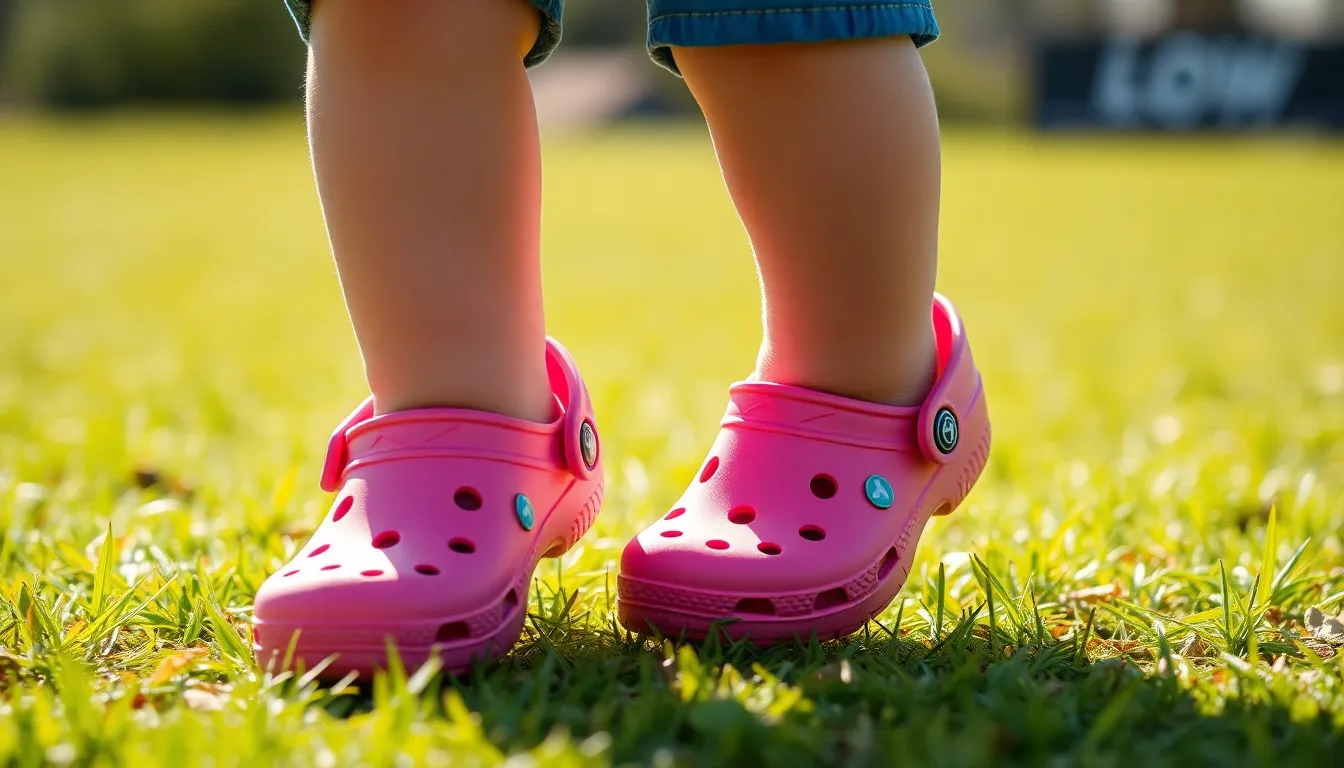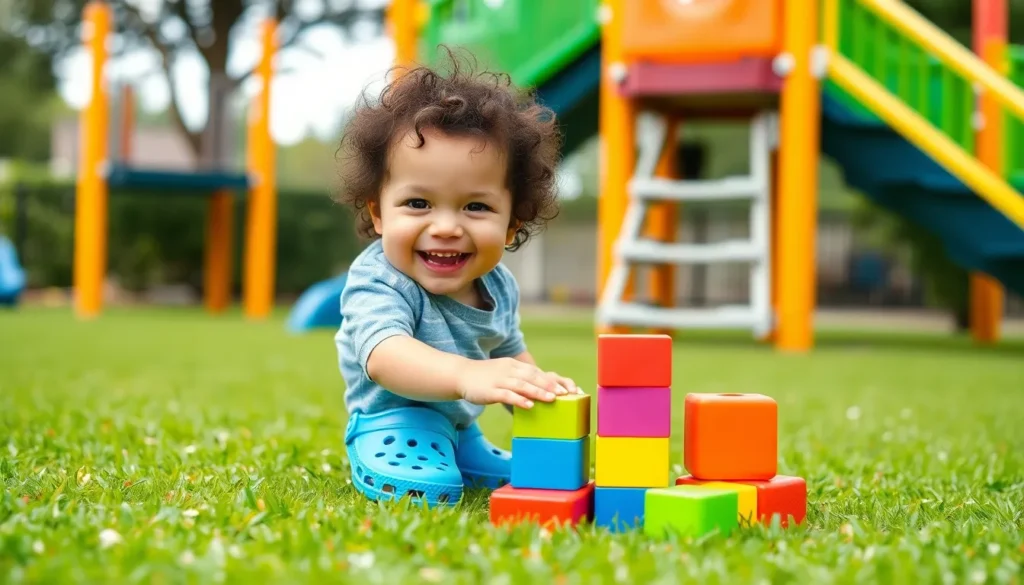When it comes to toddler footwear, the debate rages on: are Crocs a fashionable choice or just a rubbery rebellion against traditional shoes? With their bright colors and quirky designs, these foam clogs have become a staple for many little ones. But are they really the best option for tiny toes?
Parents often find themselves torn between style and comfort. Crocs claim to offer both, promising breathability and easy cleaning—perfect for those inevitable playground messes. But do they provide the support toddlers need as they run, jump, and explore? In this article, we’ll dive into the pros and cons of Crocs for toddlers, helping parents make an informed choice while keeping the fun alive. After all, who doesn’t want their child to strut their stuff in a pair of funky clogs?
Table of Contents
ToggleBenefits of Crocs for Toddlers
Crocs offer several advantages that make them a popular choice for toddlers. Parents often appreciate the unique features that enhance comfort and usability.
Comfort and Fit
Comfort stands out as one of the main benefits of Crocs for toddlers. Lightweight materials ensure easy wear, allowing little feet to move freely. Soft foam footbeds provide cushioning, promoting all-day comfort. Adjustable straps help achieve a secure fit, preventing slips during play. Sizes accommodate various foot widths, ensuring a snug feel. Toddlers can wear Crocs for extended periods without discomfort, making them ideal for busy days.
Breathability
Breathability enhances the appeal of Crocs for toddlers. The open design allows air circulation, reducing moisture buildup. This feature helps prevent sweaty feet, essential during warm weather. Easy-to-clean surfaces ensure quick maintenance, appealing to busy parents. Lightweight materials absorb shock while providing flexibility. Many parents notice that breathable footwear contributes to general foot health, thus supporting active lifestyles.
Concerns About Crocs for Toddlers

Parents often express concerns regarding the suitability of Crocs for toddlers. Issues related to support and stability stand out prominently.
Support and Stability
Support and stability are crucial for a toddler’s developing feet. Crocs lack rigid arch support, which might cause issues during prolonged wear. Toddlers engage in various activities, often requiring footwear that provides solid ankle support. Without a secure fit, children may experience instability while running or jumping. While some styles offer adjustable straps, these may not completely compensate for the lack of structured support. Parents should evaluate their child’s activity level and the overall terrain to ensure footwear matches those needs.
Material Safety
Material safety represents another critical concern when selecting shoes for toddlers. Crocs use a proprietary foam material known as Croslite, which is lightweight and waterproof. That material does not contain harmful chemicals, ensuring it is safe for children’s feet. Despite being safe, some parents worry about the risk of slipping due to the smooth sole design. Additional concerns include potential skin irritation from prolonged contact with certain materials. Ensuring the perfect size can mitigate these risks, allowing children to enjoy their footwear happily.
Alternatives to Crocs for Toddlers
Several footwear options exist for toddlers if parents consider alternatives to Crocs. Each type addresses specific needs, ensuring comfort, support, and style.
Other Types of Footwear
Sandals provide breathability and easy wear. Many styles come with adjustable straps, helping achieve a secure fit. Sneakers offer a supportive design, often made from breathable materials that cushion active feet. Water shoes function well during summer activities, preventing slips in wet environments while allowing for drainage. Each option promotes stability, essential for developing toddlers learning to walk and run.
Comparing Features
When comparing sandals to Crocs, sandals typically feature more varied designs, offering additional support with closed-toe options. Sneakers stand out with enhanced arch support, which can promote healthy foot development. Water shoes often include non-slip soles, reducing the risk of falls in wet conditions. All alternatives emphasize safety features that ensure toddlers’ comfort during play. Exploring these options helps ensure active little ones enjoy their time outdoors without compromising on support or style.
Tips for Choosing Footwear for Toddlers
Choosing the right footwear for toddlers requires attention to detail. Proper fit ensures comfort and support during playtime.
Size and Sizing Tips
Getting the correct size for toddlers matters greatly for foot health. Measure their feet regularly as they grow quickly, often changing sizes within months. When shopping, remember to choose shoes that allow for some growing room. Aim for about a thumb’s width between the longest toe and the shoe’s end. Additionally, consider trying on shoes later in the day. Feet naturally swell, so checking fit during this time ensures optimal comfort for all-day wear.
Occasion Consideration
Occasion influences the type of footwear toddlers require. Different activities call for specific shoe types. For playground use, opt for sneakers that provide support and traction. Water shoes suit beach outings, ensuring safety on slippery surfaces. Casual settings may allow for lightweight sandals, which promote breathability. When dressing toddlers for special events, consider dress shoes while ensuring they remain comfortable enough for play. Ultimately, choose footwear that supports both activity and occasion, balancing style with functionality.
Crocs can be a fun and practical choice for toddlers when chosen carefully. Their lightweight design and easy maintenance appeal to busy parents while providing comfort for little feet. However concerns about support and stability shouldn’t be overlooked.
Parents should assess their child’s activities and consider alternatives that may offer better arch support or slip resistance. Ultimately finding the right balance between style and functionality is key. By prioritizing fit and purpose, parents can ensure their toddlers enjoy safe and comfortable footwear that keeps up with their playful adventures.






